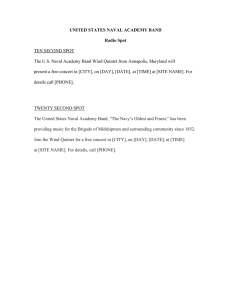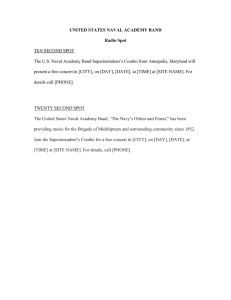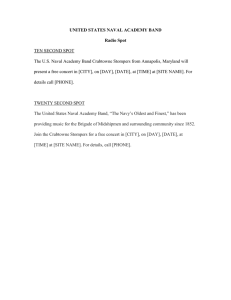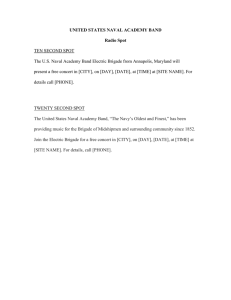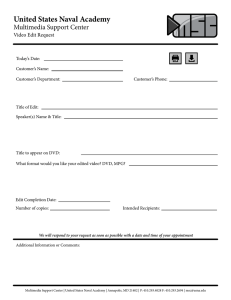F
advertisement
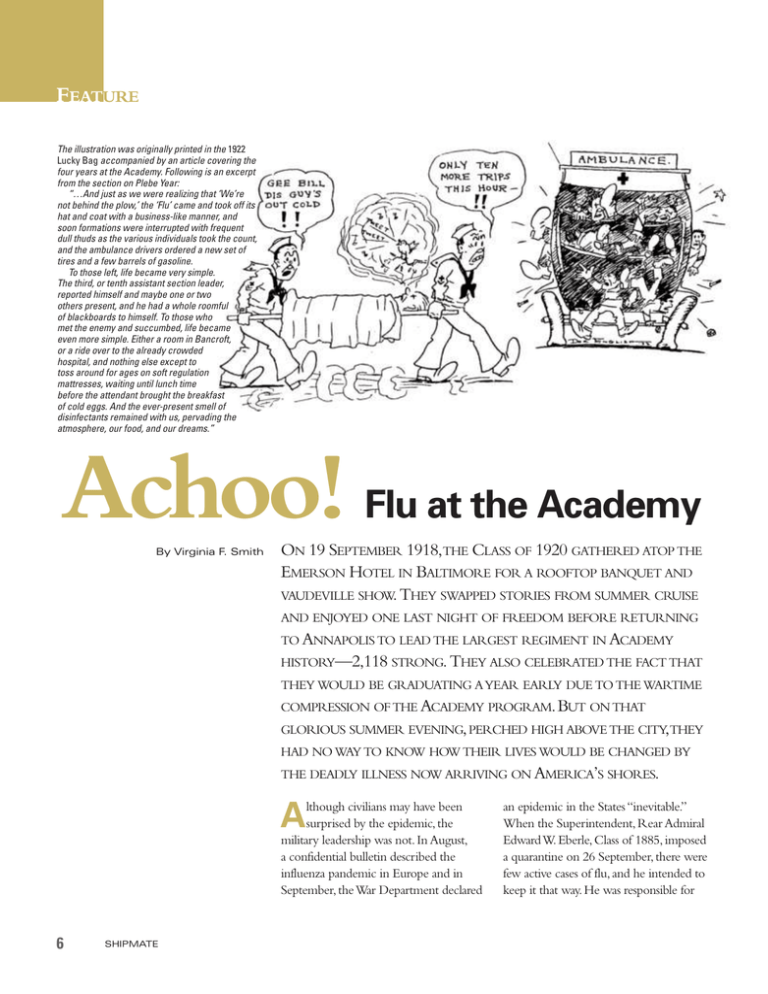
FEATURE The illustration was originally printed in the 1922 Lucky Bag accompanied by an article covering the four years at the Academy. Following is an excerpt from the section on Plebe Year: “…And just as we were realizing that ‘We’re not behind the plow,’ the ‘Flu’ came and took off its hat and coat with a business-like manner, and soon formations were interrupted with frequent dull thuds as the various individuals took the count, and the ambulance drivers ordered a new set of tires and a few barrels of gasoline. To those left, life became very simple. The third, or tenth assistant section leader, reported himself and maybe one or two others present, and he had a whole roomful of blackboards to himself. To those who met the enemy and succumbed, life became even more simple. Either a room in Bancroft, or a ride over to the already crowded hospital, and nothing else except to toss around for ages on soft regulation mattresses, waiting until lunch time before the attendant brought the breakfast of cold eggs. And the ever-present smell of disinfectants remained with us, pervading the atmosphere, our food, and our dreams.” Achoo! By Virginia F. Smith Flu at the Academy ON 19 SEPTEMBER 1918,THE CLASS OF 1920 GATHERED ATOP THE EMERSON HOTEL IN BALTIMORE FOR A ROOFTOP BANQUET AND VAUDEVILLE SHOW. THEY SWAPPED STORIES FROM SUMMER CRUISE AND ENJOYED ONE LAST NIGHT OF FREEDOM BEFORE RETURNING TO ANNAPOLIS TO LEAD THE LARGEST REGIMENT IN ACADEMY HISTORY—2,118 STRONG. THEY ALSO CELEBRATED THE FACT THAT THEY WOULD BE GRADUATING AYEAR EARLY DUE TO THE WARTIME COMPRESSION OF THE ACADEMY PROGRAM.BUT ON THAT GLORIOUS SUMMER EVENING, PERCHED HIGH ABOVE THE CITY,THEY HAD NO WAY TO KNOW HOW THEIR LIVES WOULD BE CHANGED BY THE DEADLY ILLNESS NOW ARRIVING ON AMERICA’S SHORES. A lthough civilians may have been surprised by the epidemic, the military leadership was not. In August, a confidential bulletin described the influenza pandemic in Europe and in September, the War Department declared 6 SHIPMATE an epidemic in the States “inevitable.” When the Superintendent, Rear Admiral Edward W. Eberle, Class of 1885, imposed a quarantine on 26 September, there were few active cases of flu, and he intended to keep it that way. He was responsible for safeguarding not only the midshipmen but also a 450-member Reserve unit stationed on the Yard.The conditions at the Academy, which had outgrown Bancroft Hall and spilled across the river onto the Naval Station, were ideal for the spread of disease. Nobody was happy about the quarantine. In the 1920 Lucky Bag, the Plebe class complained that the upperclassmen, trapped on the Yard with no sports or dances to divert them, focused full attention on the Plebes, making their lives miserable.The hopes of the midshipmen, and the neglected merchants of Annapolis, were undoubtedly lifted when the 1 October headline of The Evening Capital declared “‘Flu’ subsiding at Naval Academy.”Academy officials reported that the disease was well in hand and that they expected to lift the quarantine within a few days. But official correspondence sent to the Commander of the Pacific Reserve Fleet on the same day, took a darker view:“The Navy has lost four young officers, they all had the Spanish Influenza. Undoubtedly we will lose some more before the epidemic runs its course. It is a pretty bad situation.” Sadly, the official assessment was correct.And although there was a name for the epidemic—the Spanish Influenza—nobody knew why it was so deadly nor could they stop it from ravaging the population, striking healthy young people with the most force. In a typical flu season, only about 0.1 percent of infected people die of the disease or its complications. In 1918, the mortality rate was 2.5 percent, 25 times higher than normal. Furthermore, mortality is generally highest among the very old and the very young, who tend to be less able to fight off disease. In 1918, however, the deaths among people aged 16 to 40 Street, the only child of a widower father exceeded those in all other age groups who was the Academy night watchman. combined.Although exposure to an James had worked on the addition to influenza epidemic in 1889, which had a similar genetic makeup to the 1918 virus, Bancroft Hall before being drafted in May of 1918. conferred immunity to many older By a sad coincidence, on 3 October people, that is not the only reason that 1918, the day Private Connolly died at young people suffered the most. Camp Meade, MidshipmanThird Class Many of the symptoms associated William A. McDuffie, the son of a doctor with the flu, such as inflammation, aches, from Columbus, GA, died of pneumonia fever and chills, are actually signs that the body is fighting off disease.The deadliness at the Naval Hospital. McDuffie’s path through the Academy had not been easy, of the 1918 epidemic, however, has been but his classmates remembered him attributed to the overwhelming immune warmly in the 1921 Lucky Bag: response that particular virus elicited, resulting in inflammation severe enough “Mac entered with the class of ’20 to restrict circulation, dangerously high but very early decided to cast his lot fevers and opportunistic bacterial with ’21 and no class was ever more infections. Ironically, the sector of the lucky in receiving a member than population with the strongest immune when he concluded that two Plebe system, namely, those people in the prime years wouldn’t hurt any man. [He of life were now the most vulnerable. was] a friend to all, a friend indeed, Modern medical science has many and everybody’s friend.” tools to deal with influenza, but in 1918, Barely had the shock of McDuffie’s doctors didn’t even know what caused it. death been absorbed than the regiment A bacterium, called Pfeiffer’s bacillus, learned that a Plebe had died. Elihu C. rather than a virus was believed to be Grace, the son of a stave manufacturer the cause. It is now known that this from Mobile, AL, was a slender young bacterium (Haemophilus influenzae) caused man with brown eyes and black hair. secondary infections such as pneumonia, He was a gifted student, scoring a perfect but not the influenza itself. Because 4.0 in algebra on his entrance exam, and influenza was poorly understood, it would surely have done well at the is not surprising that many medical professionals treating the epidemic fell victim to it. Such was the fate of 28-year-old Private James M. Connolly, an Army medic who was the first “Annapolis boy” to die in World War I. He died not in a distant field or trench, but of pneumonia at the Camp Meade Army hospital 20 miles away. Private Connolly had grown up in the shadow of the Naval Academy on King George Gustuson and Duniway gravesites October 2008 7 FEATURE Academy. Grace died at midday on 4 October with his mother and brother at his side. His body was shipped home for burial, barely three months after his 17th birthday. Less than a day would pass before Midshipman First Class Harry S. Latta, the son of a widowed factory superintendent from Goshen, IN, died of influenza on the morning of 5 October. Latta had spent his summer cruise aboard ARKANSAS, a battleship that deployed to Scotland in mid-July, and he was undoubtedly full of stories to share with his younger brother William, who went on to graduate with the Class of 1922. The pages of The Evening Capital reflected the spiraling situation.The county health officer treated 155 patients in one day. Public and private schools were closed indefinitely.The hospital was closed to all visitors; church services throughout the city were cancelled.The mayor of Annapolis closed the movie theaters, and people were asked not to make telephone calls because of a shortage of switchboard operators.At the Academy, all indoor gatherings were banned. Chapel services were suspended as was everything resembling an assembly.This ban did not extend to academics, however, the Lucky Bag reported that classes went on as usual, no matter how few made it to class. 8 SHIPMATE The Evening Capital, which now admitted a “gloomy outlook” for the influenza, reported the deaths across Annapolis including a wealthy matron, a livery man, a prisoner in the city jail, an Army cadet at St. John’s College and Brigadier General Augustus Doyen, USMC, Class of 1881.The deaths at the Naval Academy on 7 October mirrored those of Annapolis: a baker, a pharmacist, a nurse, the teenaged son of an officer, and finally, Midshipman First Class Robert G. Campbell Jr. At 5’6” and 190 pounds, Campbell was a sturdy youth with gray eyes and brown hair. Following his summer cruise on KANSAS, a battleship serving in the Atlantic Fleet, he had been selected to serve as a regimental officer from 7th Company. Campbell’s mother traveled up from New Orleans and was with him when he passed away. The influenza epidemic hit its peak in the United States in the first two weeks of October. Its peak at the Naval Academy could be pinpointed even more precisely to 8 October, the day two midshipmen died within an hour of each other. At noon, Midshipman First Class George E. Gustuson, the son of a widowed working mother from Chicago, died of influenza. Gustuson had spent his summer cruise aboard UTAH, a dreadnought operating in the waters of the Chesapeake Bay, returning to serve as a regimental officer in 6th Company. Barely an hour later, Midshipman Fourth Class Malcolm S. Duniway, the son of a lawyer William A. McDuffie from Portland, OR, was claimed by pneumonia. Duniway arrived at the Academy with a year of college under his belt and was a member of 3rd Company. Tall and slender, with dark brown hair and brown eyes, Malcolm Duniway died 3,000 miles from home on the day after his 19th birthday. The Dark Ages began early that year. The parents of both young men requested that they be buried at the Naval Academy, probably more from necessity than choice. Not only were there limited refrigerated train cars to transport the dead, but there was a nationwide shortage of caskets, undertakers and gravediggers because of the influenza.As classmates took up a collection for the headstones,Admiral Eberle issued orders directing a double funeral to be held the next day. At precisely 3 p.m. on 9 October 1918 the colors were lowered to halfmast as the funeral service began. On that crisp fall afternoon, a cortege carried the caskets from the Naval Academy Chapel to the cemetery, escorted by the Naval Academy Band and members of 6th and 3rd Companies. Classmates served as pall bearers, and each company provided a rifle detail. Gustuson and Duniway were laid to rest, side-by-side in their dress uniforms on hillside plots high above College Creek.At 4:30 pm, the colors were raised, ending a brief yet poignant period of mourning. Harry S. Latta As the funeral service concluded in the cemetery below, Mary Sturtevant, a widow from Chicago, sat helplessly at her son’s bedside in the Naval Hospital. Midshipman Third Class Eldred Sturtevant died later that night, and his body was shipped home for burial. His classmates wrote in the 1921 Lucky Bag: “Youngster year, when the flu came with the end of September leave, Eldred was one of the first to go to the hospital, never to come back to us.The hand that beckoned to so many throughout the land that year beckoned to him also, and he went to answer the last great call of all.” Meanwhile, life haltingly returned to normal. On 10 October, the Naval Academy welcomed Secretary of the Navy Josephus Daniels and a British Navy delegation. St. Johns College lifted its quarantine and resumed classes and Army training. The Evening Capital reported that, despite eight deaths in the last day “the disease seems to have spent its force, and the worst is over.” Despite these promising signs, the Academy would soon lose Midshipman First Class William S. Crowell, who died shortly before midnight on the 10th. A hearty 5’10” and 210 pounds, Crowell was the son of a coal company executive from Philadelphia. Crowell had spent his summer cruise on NEVADA, a battleship that trained destroyer crews and gun crews along the East Coast.The regiment Robert G. Campbell Jr. had now suffered eight deaths in as many days. The last two midshipmen to die of the influenza were Plebes. Midshipman Hugh Sherwood Mayo was the only son of Frederick and Jennie Mayo who lived in Little Rock,AR. Only 17, Mayo was slender and pale, with blue eyes and dark brown hair. Despite the heart-breaking circumstances,his parents wrote a touching letter to thank the Superintendent for “the privilege which our son, Sherwood, enjoyed within those noble uplifting surroundings for the two short months and one day transpiring between his entrance into the Naval Academy, August 15th and the time of his death October 16th.” They praised the medical staff for the quality of their care and thanked the government for the “beautiful casket” and for the “glorious flag” from REINA MERCEDES, the Academy station ship captured in the Spanish-American War. Five days later, on 21 October, Midshipman Carl S. Benedict passed away of cerebral meningitis before his parents could arrive from Austin,TX. Only 5’4” and 125 pounds, Benedict had blue eyes, black hair and a ruddy complexion.After his son’s death, Professor H.Y. Benedict, Dean of the College of Arts and Sciences at the University of Texas (later to become the university president), wrote to Admiral Eberle thanking him for his courtesy. Among the personal belongings returned George E. Gustuson to the family was a stack of stamped blank postcards, enough to allow the midshipman to write home once a week his entire first year. When it was apparent that the worst was over, activities resumed in an almost frenzied way. On 26 October, the quarantine was lifted, Navy played its first football game of the season and a card hop was held.Two days later,Assistant Secretary of the Navy, Franklin Delano Roosevelt, who had suffered from the flu himself, paid a visit.The popular captain of the football team, who was also the regimental commander, returned to practice after a lengthy convalescence. Making up for lost time, the football team practiced until after dark with illumination provided by the searchlights of REINA MERCEDES. And on 30 October, the Eberles held their first “at home” of the season, serving refreshments to visitors at Buchanan House. Of course, nothing did more to heal the scars left by the epidemic than Armistice Day on 11 November.To celebrate the occasion, midshipmen were excused from drills, and the upper classes were given liberty to visit Annapolis and the Officers’ Quarters.The epidemic must have seemed a lifetime away. Epilogue The influenza epidemic of 1918 killed more than 20 million people worldwide. In the United States, approximately 700,000 died.When the influenza arrived Eldred Sturtevant William S. Crowell FEATURE at the gates of the Academy in late September, the deck was stacked against the staff of the Naval Hospital. But in fact, the record of the Naval Academy medical team was remarkable by any standard. Of 2,118 midshipmen, an estimated 1,100 contracted influenza, an infection rate of 52 percent, nearly twice the national infection rate (28 percent).Yet, of those infected, only 10 died, for a mortality rate of 0.9 percent, about 10 times below the mortality rate of eight to 10 percent observed in the general population for the age group. What can account for these impressive results? It wasn’t because the midshipmen were a healthier group to begin with, because stronger individuals were actually at greater risk because of their massive immune response. Secondly, it was not because the Navy had access to superior medical knowledge or treatments. In those days before antiviral and antibiotic medications, there were no cures, only preventive measures and palliative treatments. There is no single explanation for the Naval Academy’s favorable outcome. Instead, it was probably a combination of many things: the skill and dedication of Navy and civilian medical personnel who toiled around the clock, the quarantine that prevented new cases, the continuous availability of coal for heating at a time when the country was experiencing shortages, the nutritious food provided to patients throughout their illness, the enforcement of good hygiene and last, but not least, the discipline to keep everything running smoothly. If the Naval Academy had experienced deaths at the rate of the general population, between 90 and 110 midshipmen would have died rather than 10. Although we cannot know what contribution these 10 young men might have made, we can be sure that the loss of 100 future officers would have been significant. There can be no doubt that the exemplary care provided to midshipmen in 1918 preserved many of them to become our nation’s leaders during World War II and for years to come. a Virginia F. Smith, Ph.D., is an associate professor of chemistry at the United States Naval Academy. Thank you to the staff of the U.S. Naval Academy Archives, the Multimedia Service Center and the USNA Cemetery for their generous assistance on this project.
